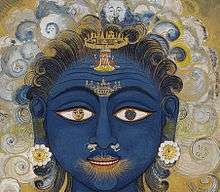Brahmapura

In Hinduism, Brahmapura is the abode of Brahma, one of the three Trimurti. It is located on Mount Meru. It is also referred to as Brahmaloka or Satyaloka in all of the puranas. Brahmapura is the topmost loka within this material universe.
Upanishads, Advaita
In the Puranas, and already in the Atharvaveda, there are fourteen worlds, seven higher ones (vyahrtis) and seven lower ones (patalas), viz. bhuu, bhuvas, svar, mahas, janas, tapas, and 'satya' above and atala, vitala, sutala, rasaataala, talatala, mahaatala, patala and naraka below.
During each pralaya, the lower ten realms (loka) are destroyed [1] while the higher four realms, including Satya-loka, Tapa-loka, Jana-loka, and Mahar-loka are preserved. During each Mahapralaya, all 14 realms are destroyed.
The Chāndogya Upaniṣad says in 8:1:1[2] that within the Brahmapura "is an abode, a small
lotus-flower within which is a small space (antarakasa). What is within that, should be searched
out; that, assuredly, is what one should desire to understand."
Further there are Hiranyapura [3](golden city) and Siddhapura[4] or White Island.
Trimurti
Brahma loka, Vaikuntha loka (Vishnu), Shiva loka are seen as the same and form together the highest loka (dimension) of the 14 lokas. 'Satya loka' is at their top and can be looked at as the lowest plane of Para Brahman. Narayana is also venerated as Para Brahman and therefore to pervade all the 14 lokas and the entire Brahmanda (Universe) which includes both manifested (planets, stars, galaxies, black holes, etc. which constitute 25% of the Universe) and unmanifested (the unknown dark matter which constitutes 75%) energy. Lord Vishnu who is said to live in Vaikuntha is a localized form of the infinite Narayana.
Buddhism
Here is Brahmaloka the highest of the celestial worlds, the abode of the Brahmas. It consists of twenty heavens : the nine ordinary Brahma-worlds, the five Suddhāvāsā, the four Arūpa worlds, the Asaññasatta and the Vehapphala (e.g., VibhA.521).[5]
See also
References
- ↑ B. K. Chaturvedi (2004). Shiv Purana. Diamond Pocket Books. p. 124. ISBN 8171827217
- ↑ http://ishwar.com/hinduism/holy_upanishads/chhandogya_upanishad/part_08.html
- ↑ http://www.sacred-texts.com/hin/m03/m03172.htm Hiranyapura
- ↑ "Archived copy". Archived from the original on 2012-06-29. Retrieved 2013-02-19.
- ↑ http://www.palikanon.com/english/pali_names/b/brahmaloka.htm Palikanon about brahmaloka
Literature
- Self-Realization Brahmaanubhava: The Advaitic Perspective of Shankara: Brahmaanubhava : The Advaitic Perspective of Shankara (Cultural Heritage and Contemporary Change. Series Iiib, South Asia, V. 4) von Vensus A. George von Council for Research in Values & (Januar 2001) - page 103
- Sharma, Shubhra. Life In The Upanishads. Abhinav Publications; 1 edition (February 14, 2011)
- chhandogya upanishad as PDF
- Twitchell, Paul (1988) The Far Country. Illuminated Way Publishing. ISBN 0-914766-91-0
- Twitchell, The Far Country as PDF
